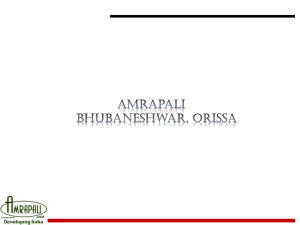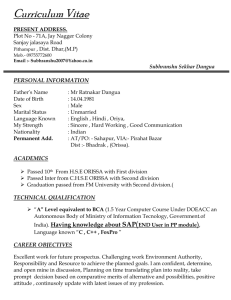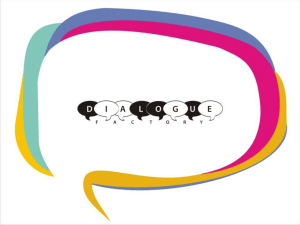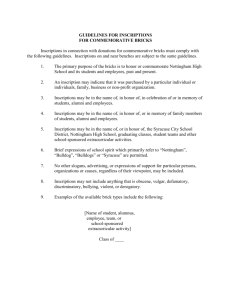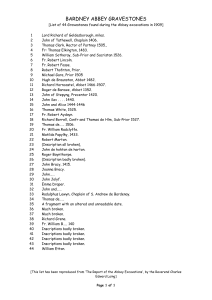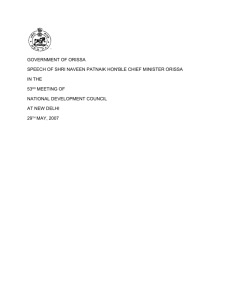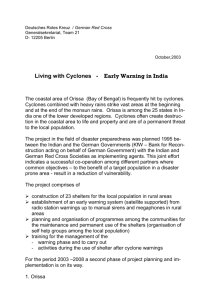Memories of My Father Padmashree Dr. Satya Narayan
advertisement
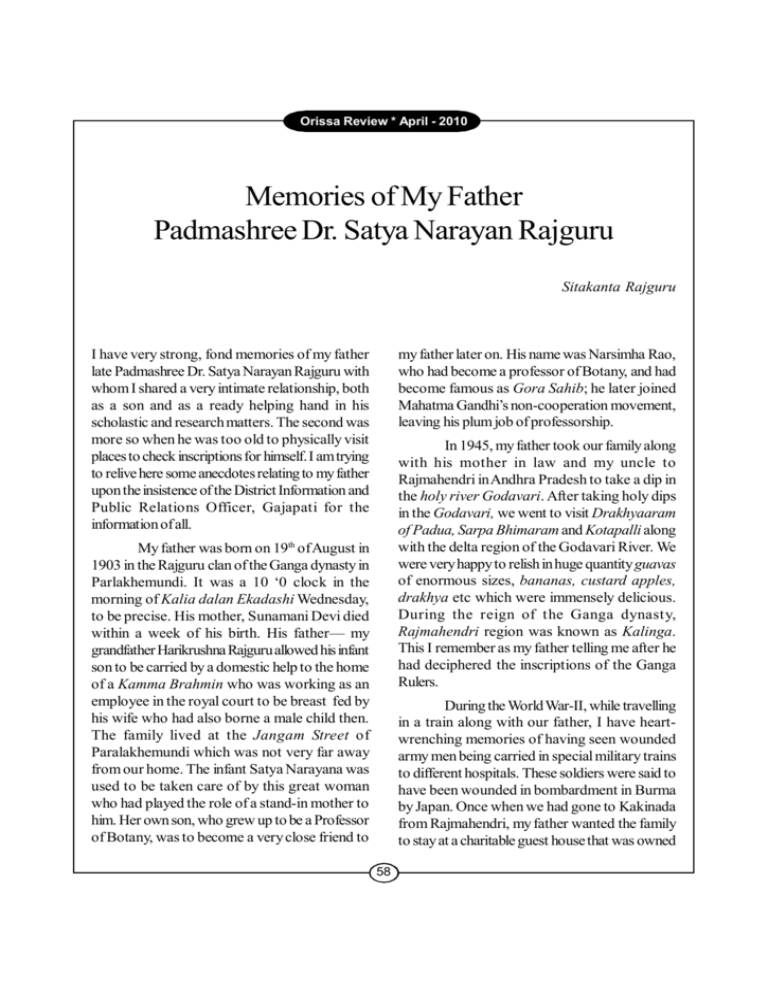
Orissa Review * April - 2010 Memories of My Father Padmashree Dr. Satya Narayan Rajguru Sitakanta Rajguru my father later on. His name was Narsimha Rao, who had become a professor of Botany, and had become famous as Gora Sahib; he later joined Mahatma Gandhi s non-cooperation movement, leaving his plum job of professorship. I have very strong, fond memories of my father late Padmashree Dr. Satya Narayan Rajguru with whom I shared a very intimate relationship, both as a son and as a ready helping hand in his scholastic and research matters. The second was more so when he was too old to physically visit places to check inscriptions for himself. I am trying to relive here some anecdotes relating to my father upon the insistence of the District Information and Public Relations Officer, Gajapati for the information of all. In 1945, my father took our family along with his mother in law and my uncle to Rajmahendri in Andhra Pradesh to take a dip in the holy river Godavari. After taking holy dips in the Godavari, we went to visit Drakhyaaram of Padua, Sarpa Bhimaram and Kotapalli along with the delta region of the Godavari River. We were very happy to relish in huge quantity guavas of enormous sizes, bananas, custard apples, drakhya etc which were immensely delicious. During the reign of the Ganga dynasty, Rajmahendri region was known as Kalinga. This I remember as my father telling me after he had deciphered the inscriptions of the Ganga Rulers. My father was born on 19th of August in 1903 in the Rajguru clan of the Ganga dynasty in Parlakhemundi. It was a 10 0 clock in the morning of Kalia dalan Ekadashi Wednesday, to be precise. His mother, Sunamani Devi died within a week of his birth. His father my grandfather Harikrushna Rajguru allowed his infant son to be carried by a domestic help to the home of a Kamma Brahmin who was working as an employee in the royal court to be breast fed by his wife who had also borne a male child then. The family lived at the Jangam Street of Paralakhemundi which was not very far away from our home. The infant Satya Narayana was used to be taken care of by this great woman who had played the role of a stand-in mother to him. Her own son, who grew up to be a Professor of Botany, was to become a very close friend to During the World War-II, while travelling in a train along with our father, I have heartwrenching memories of having seen wounded army men being carried in special military trains to different hospitals. These soldiers were said to have been wounded in bombardment in Burma by Japan. Once when we had gone to Kakinada from Rajmahendri, my father wanted the family to stay at a charitable guest house that was owned 58 Orissa Review * April - 2010 by his friend Gora Sahib. Its caretakers, who actually were a Telegu couple, refused us permission on the ground that we Oriya were fond of eating fishes. Of course we were allowed inside after Gora Sahib intervened at my father s behest. We had our dinner at Durga Bai Deshmukh s home upon being requested to do so by Professor Gora. Durga Bai was much interested to know about the heroic exploits of the rulers of Kalinga from my father. After dinner, we returned the same night to Kakinada railway station. During those days, a narrow gauge train used to run between Kakinada and Sambarlakota. The train arrived at 2 AM. As there was too much military movement there, the station master had told us take rest in the waiting room after locking it from outside. He was disappointed to learn that my father was then living in Bhubaneswar. He said he wanted to take help of my father in translating Acharya Binoba Bhabe s and his speech in Hindi into Oriya in a meeting to be held in Bhubaneswar. My father always wanted to keep me with him. In 1946-47, a research institute was formed with the collective efforts of my father and the kings of Balangir and Kalahandi. The fund was made available jointly by the above royal heads. This was before the princely states had been annexed into the Indian Union. Once my father Satya Narayan Rajguru and Sri Kedarnath Mahapatra were riding on the back of an elephant of the Maharaja of Kalahandi, named Bir Bahadur to the Gudahandi Mountain to do some heliography research there. When they were passing through the dense forest, they noticed a Red Indian tiger following the trails of the elephant. The elephant was aware of this, so it was expressing its concern by raising its trunk and blowing trumpet every once and the while. After some time, suddenly the tiger overtook the elephant and jump crossed the road in front of it. My father had a narrow escape from a tiger. On another occasion when he was returning with the Maharaja of Kalahandi from his guest house after meeting a Caucasian gentleman. He gave a reason for this frequent face to face encounter with the beast as fate s way of paving out success after turbulent trials. Professor Gora was a true follower of Mahatma Gandhi. Despite being a high caste Hindu, upon being inspired by Gandhiji s social movement to eradicate untouchability, he had his two sons and a daughter get married to harijans. There is a Patamatta Ashram in a Harijan Basti of Vijayawada that belonged to him. When he got his two sons Arun and Varun married to harijan girls, his angry parents used to write letters to my father expressing their dissent at their son s social reforms. I had the privilege to play host to Professor Gora who had visited our home in Paralakhemundi in 1954 for a second time. He had taken pains to visit Paralakehmundi to see my father. He was a tall, fair man with exuberant glow on his face. When I offered to wash his Khadi clothes for him near the well in our home, he refused saying that he loved to do his own work. Now that was Gandhiji s inspiration. I helped him with a bucket of water which I had drawn from the well. When the water did not produce much foam even after half of the soap was wasted rubbing on the clothes, he told me that the water of our well was in fact hard water . My father always went to retrieve inscriptions engraved on stone or metals whenever and wherever he heard of them being found at various places. He would decipher them and read the text and get them published in Journals published by Bihar Orissa Historical Research Society, Andhra Historical Research Society and Kalinga Historical research Society. All the above research works published by him then have found 59 Orissa Review * April - 2010 site at Sishupalagada by Archaeological Survey of India, New Delhi. We saw shielding water canals of Gangua River surrounding the Sisupalagada. We entered the fort through the passage and saw the existence of a small hamlet inside it. I was very excited. Upon seeing a stone carving of Goddess Durga there, I climbed up to the heap of dug out earth and started collecting terracotta jewellery from inside the earth. I discovered a terracotta seal at the site which I handed over to my father. One line of letters was legible enough to read. My father read that inscription in Pali script and said that it read as Amandas, Sapa, Sanaka , which must have remained the name of one individual. This seal was used to allow entry into the fort. My father gave away this seal to the state museum. It is kept there. In a little distance from here, there stands the majestic Dhauli Hill which has the River Daya flowing nearby. The Asokan Inscription there and the inscriptions in Palli in Khandagiri and Udayagiri caves done by Kharvela were read by him, which he would elaborately discuss with me. place in Bibliotheca Indicia of Holland. It was him who had stressed upon the need for Asuragada excavation. Similarly it was my father who had written to the then chief minister of Orissa Sri Nityananda Kanungo that the state must have its own museum in its capital Bhubaneswar that would help historical research. This was in 1948 when Sardar Ballabh Bhai Patel had already annexed the princely states into Indian Union. In 1950, a meeting was held at Balangirpatana under the chairmanship of a great scholar and indologist Prof. Reverend Horace of Pune s Xavier University. That meeting was attended by the chief minister of Orissa Sri Harekrushna Mahatab, the speaker of Orissa Legislative Assembly Sri Nilakantha Das, Maharaja of Patana Sri Rajendra Narayana Singhdeo, Maharaja of Kalahandi Sri Pratap Keshari Deo and Prof. Sarbeswar Das among others who participated in the discussion to set up a State Museum in Bhubaneswar. Prof. Reverend Horace expressed his desire to stay in Orissa and do his research on India under the guidance of my father Satya Narayana Rajguru. My father told him that Orissa s history was still lying in the thick of darkness, hence he must first write the history of Orissa. As such, the State Museum was first set up in 1950 and it ran from a rented building in the old town of Bhubaneswar. My father and I lived in a thatched house near the Lingaraj Temple. Visitors would come and visit the temple during the daytime and those who intended to stay would stay at the Doodwala Dharamshala there. Once the evening sets in, the whole area surrounding the Lingaraj Temple would wear a deserted look and complete silence. The capital was then witnessing construction of a few buildings for office and residential purposes. I was then studying at B.M. High school there. I would like to narrate some of his descriptions of those inscriptions below. Nobody knows who ruled over Kalinga when it was attacked by Emperor Asoka. In 1977 when my father was in Parlakhemundi, he was despatched three photocopies of copper plate inscriptions from the state museum in Hyderabad. These inscriptions were found from under the earth near Sirakhandi village which is a few miles away on the other side of the River Mahendratanaya from Paralakhemundi when road work was being undertaken there. As this area fell under the territorial limits of Andhra Pradesh, the Collector of Srikakulum sent them to the museum at Hyderabad. The photocopies of them had been sent to my father with request to read the inscriptions as nobody had been able to decipher Once, I alo ng with my cousins accompanied my father to the freshly excavated 60 Orissa Review * April - 2010 harvesting, he would spend his time there and write pages of History of Orissa there. them there. He had to work hard for nearly seven months to decipher those inscriptions. He found that the said inscriptions were written in ProtoOriya script of ancient times. Interestingly, my father was asked to contest elections by Maharaja Pratap Keshari Deo of Kalahandi in 1957, and he had contested elections for Parlakhemundi Constituencies the same year from the Democratic Party which he had lost. As there was no epigraphist available at that time, my father was appointed a Curator on contract basis in Orissa State Museum. It was during these times that he wrote three parts of the book Inscriptions of Orissa-V volume which were published by the Museum authority. The volumes I to IV of the same book had been published previously by it. Only the two parts of the IIIrd volume of the book Inscriptions of Orissa were published by the Orissa Sahitya Academy; the latter had also published my father s drama book Chandrakala Natika in English and Sanskrit. The Cultural History of Orissa (III and IV), Upabhasa, Kalingara Atmakatha, Odia Lipira Krama Bikash, Odia Lipi O Bhasa, Sri Purusottama and Sri Mandir etc had been published and sold. Apart from this, some 1500 articles of my father had been published in different journals and magazines which include Orissa Historical Research Journal, Konark, Utakal Prasanga, Orissa Review, Sahakar, Asanta Kali, Jhankar, Sankha, Rupayana, Samaja etc. Besides, my father was a regular contributor from 1989 to 1997 to magazines called Nirmalya and Niladri which were published by the Jagannath Sanskrit University of Puri. From these inscriptions it was found that the King of Kalinga who belonged to Chaita dynasty and had the name Suratha came to far off South riding a horse along with a merchant and performed a yajna with the hring mantra. This is mentioned in the Sapta Sata Chandi Purana also. He established his small kingdom from Gangabada to Agrabada. His successor invaded Magadha twice and defeated it. He was the famous king Kharavela. Thus these inscriptions proved that it was King Suratha of Kalinga who had fought the famous Kalinga War with Emperor Asoka. Emperor Asoka had failed many times before when he had attempted to invade Kalinga. He had learnt diplomacy and warfare from the Greeks and had planned his invasion of Kalinga eight years in advance. The inscriptions tell that it was for the first time during the Kalinga War that battles were fought even after sunset till midnight. King Suratha was caught napping when Asoka had invaded Kalinga. After his defeat, he had run to the Deep South. My father Satya Narayana Rajguru was a dedicated research scholar. When at work, he was in the habit of withdrawing from the outer world completely. He would usually begin his day with a cup of tea and start his studies and research work. Similarly he would retire to his bed much late in the night with a cup of tea. He was a living bibliography. While writing the History of the Gangas at the behest of Maharaja of Parlakhemundi, he had gone to the Canberra Library in Madras and National Library in Calcutta. He was also very fond of agriculture. He used to walk some three kilometers to Badakhinga village where we have some agricultural land. At the time of reaping and My father and I later joined as honorary research associates for the ongoing research project being carried out at the Jagannath Sanskrit University. Excavations were being carried out at Puri Jagannath Temple, Nrusinha temple, Pataleshwar temple of Puri. Other areas in Puri where excavations were being done were Punjiama, Charchika, Kuanri Kamakhya of 61 Orissa Review * April - 2010 unpublished plays are Kharvela, Dharmavatar, Sita, Kalinga Vijaya, Asoka etc. The second part of the History of Naga and Manorama Kavya could not be published. The Volume III of the Invocatory Verses from Inscriptions has not been printed yet. Gobindpur of Puri district. Many Jain idols were recovered from under the earth at the Bhabani Shankar Temple near the Mahtab School in Bindu Sagar Tank area. An ascetic had recovered these Jain idols. We came to know from inscriptions there that Bhubaneswar was earlier called as Sudhachal. Similarly, from the inscriptions found at Boitalu Temple, we learnt that the goddess worshipped there was Lankeswari. There are some 71 stone inscriptions in the Lingaraj Temple. Some of them are in North Indian Scripts while others are in the South Indian Scripts. Inscriptions on Jaydev and Bira Choda have been found in the Lingaraja Temple. Bira Choda was said to be an uncle of King Chodaganga Dev. My father has published his reading of these inscriptions in the volume I & II of Inscription of Puri Temple Sri Purshottam Jagannath published by the above university. My father was conferred with the prestigious Padmashree award in 1974. The Berhampur University awarded a D.Litt to him in 1975. He received Orissa Sahitya Academy Award, the Kendriya Sahitya Academy Award, Sarala Samman, felicitations from Orissa History Congress, Utkal Ratna and many others. In 1974, my father had been to the Manuscript Library in Madras to study Mackenzie s original 18th century research papers on various kings of Orissa. When he met the superintendent of the museum Dr. T. Ramchandran there, the latter requested him to read a stone inscription kept there which he said could not have been read by anyone there. My father went to the place where it was kept on a high dais. He had brought it down with the help of a peon for a closer inspection. My father had never seen a strange script like this before. He doubted the positioning of the inscription and had it placed upside down. It was readable now. His reading of it revealed that it was inscribed by King Mukunda Dev-II. During the time of Ram Chandra Dev, he had its estampage taken from Puri. Once when he was engrossed in his reading of the same, my mother had left my elder brother, who was a kid then, in the same room as my father s, because she was too busy in cooking to look after him. The kid had soon messed with all his research papers, having attended to nature s call a repeated times. When the stink of it disturbed my father s engrossed reading, he was upset enough to throw all his papers into the dustbin. When he went to Puri again to get the estampage of the same inscription for a fresh Once when my father slipped and had fractured his leg at our residence in Parlakhemundi, I had to live in Puri to collect the estampage of inscriptions from various temple ruins in Puri district. I found inscriptions relating to Kapilendra Dev in the dilapidated Kedareswar temple. I received a telegram from home that my father was being treated in Berhampur Medical College after being hit in a road accident. My father was 90 years old then. The doctors had advised against surgery due to his ripe age, he was given traction instead. From there, he preferred to go to Puri to continue writing his history of Orissa rather than going to Parlakhemundi for rest. My father was awarded a degree in Sanskrit and Odia, besides in Indology from Visakhapatnam University in Andhra Pradesh in 1930. During his incumbency in State Museum, his other published works included Radhaviseka Nataka, Janani Utkal Khanda Kavya, Gajapati Nataka, Januaryra Sodasa Ratri, Sri Jaydeva, Gita Gobinda plays etc. Amongst his 62 Orissa Review * April - 2010 Dash, Maharaja of Patana Shri Rajendra Narayan Singhdeo, Maharaja of Kalahandi Sri Pratap Keshari Deo, advocate general of Orissa Sri Rama Chandra Mishra among others had also testified before the above committee. I was busy making all arrangements for their royal meal, which was catered in accordance to a befitting royal menu. As they were having their meals in a house adjacent to our home in Parlakhemundi, I had the privilege of hearing them say that Rajguru s efforts had borne true rewards, and that it had prevented the second division of Orissa. reading, it was found to have been moved to elsewhere. It is worth mentioning here that the same inscription had been found from the goddess Bimala s well there when it was being cleaned. When he finally located the inscription in the Madras Museum again, his joy knew no bounds. In the sweltering heat of April summer in Madras, he spent two weeks there translating the 18 th century rare book, Jaganath sthala brutanta from Telegu into English. One day, the superintendent of the museum asked him not to touch the pages of the book with his sweating hand fearing it might be soiled and damaged. One of his men had been asked to turn over the pages of the book as my father would read it for research and translation. He had even put restrictions on the use of ceiling fan during these reading and writing sessions. As a result of this, my father had to make frequent break-ups to go outside to get relief from the sweltering, sweating heat. At times, many foreigners used to visit Dr. Satya Narayana Rajguru both at Bhubaneswar and Paralakhemundi. Once three American ladies by the names, Magdalene, Joan Williams and Linda Mary had visited Paralakhemundi to meet him. They proposed to visit the Mahendragiri hills with him. My father was 82 then. We arranged a vehicle with the help of the TDCC manager and along with the vehicle, in which these foreigners had come, went to Mahendragiri. My father was initially in doubt if he could climb up the height of 4,900 feet at that age of his. As I had been to Mahendragiri twice before, I described the possible difficulties which we might face there, and told him how one could experience there in a single day all the seasons of the earth. Though the pain taken to climb the mountain was breathtaking, yet once one was in the middle of mountain ranges, the panoramic view and the suave touch of descending clouds on one s body would have a very soothing, spiritual effect on him. We all together, along with my two sons, Raghuraj and Ram Shankar, started to climb up the mountain on foot. It was the sweltering hot day of March. We had taken sufficient green coconuts and Sapota fruits with us. But while climbing the mountain, we did not feel like eating them, we wished we had rather brought biscuits and breads to eat. My father Dr. Satya Narayana Rajguru had also played an important role in the movement for formation of the Orissa State. Upon being directed by Maharaja Krushna Chandra Gajapati Dev, he had been to Gopalpur to present a memorandum before the O Donnell committee. He had testified before the same commission in 1930. Similarly, in the year 1958, when he was working with the Orissa State Museum, his office was shifted to Paralakhemundi for two months to enable him submit a memorandum and testify before the SRS Commission that was set up after the Andhra Pradesh government demanded the region of Parlakhemundi as its part. He had submitted a memorandum on behalf of the Orissa government to the Panicker and Kunjuru Committee and also testified as a witness before it. This had taken place in the present Circuit House building in Parlakhemundi. On this day, the ex-chief minister of Orissa Shri Biswanath 63 Orissa Review * April - 2010 My father looked all around when he had reached the summit and opined that it must have remained a mountain fort at some point of time. He collected a few samples of stones and terracotta. Upon finding the statue of Lord Vishnu in a dilapidated temple and a stone inscription there, we collected the estampage of the inscription. Similarly he also found an inscription at the Yudhishtir Temple there which later turned out to be carved by King Rajendra Chola of the famous Chola dynasty. There was backdoor at the Bhima Temple in Mahendragiri which was four feet by height and one foot by width. Tradition has it that only a saintly man could enter through that passage. The sinners would not be able to manage to enter through that gate. I could manage to get through that passage. We went to the Gokarneswar or Kunti temple where we found a fair skinned Sadhu sitting in meditation in white clothes, wearing a tilak mark on his forehead. Some of the thatched cottages, made of creepers by traders to do some business during the festival of Shiv Ratri had been demolished by a herd of four elephants. But the cottage that belonged to the Sadhu had been miraculously spared by the pachyderms. The area was littered with the elephants stools. I drew some water from the well there with the help of a rope made from the thin tree bark. The Sadhu happily accepted the fruits which we gave him. Out of curiosity I asked him what was he feeding himself with at that lonely mountain top. In reply, he said that his opium smoke and a handful of rice were enough for him. He also informed us that he had come to live there since Sankanti when he was not allowed to join a group of sanyasis in Rishikesh. He was from Berhampur and his name was Baishnab Mahapatra. When we returned to the foot of the mountain, at the Burkhat, which is a tribal settlement there, some tribal asked me if I had seen someone up there. When I told them about the Sadhu there, they were apprehensive that he must have been none other than the Lord Parsuram himself. In conclusion, I must say that from 1945 to 1997 June 11th, from my birth to the time when he died, I have cherished the company of my father. I have memories of my father who had actively lived his life as a true servant of the nation, social reformer, poet, litterateur, historiographer, scholar and politician. My mother Taramani Devi breathed her last in the Jagannath Sanskrit University premises in Puri in the month of June in 1996 and I performed all funeral rites as per our tradition. One day my father told me, Your mother used to say that we were not saving anything for our old age. But with the blessing of Lord Jagannath, we got many awards that helped a lot in our old age. He was very active till the end of his life. In 1997, some time before his death, he recorded his interview with the All India Radio for eight hours continuously without taking a break in between. This interview was recorded in eight cassettes. In the end, the director of AIR thanked him, saying that to be able to record continuously for eight hours at such a ripe age is very tasking a show of utmost humility, patience and perseverance which is rarely found. Sitakanta Rajguru lives at Chitr akar Sahi, Paralakhemundi, Gajapati. 64
